If you are looking for another way to help make some foods last longer, have you considered turning them into a powder form? Many popular powdered foods are protein based, and they can be used in various ways.
Now keep in mind, you aren’t going to turn a filet mignon into powder and expect to sit down for a steak dinner when using it in the future. It just doesn’t work that way, unfortunately.
But there are ways to use these powder foods that will enhance a meal, keep you in stock of good and healthy products that can be stored longer than if you attempted to store it in its original state.
And, as a bonus, it takes up far less room on the shelf or fridge.
I am going to discuss which foods I found that can be turned into powder, how to store them, and how to use them when you are ready.
How to Turn Foods into Powder Form
If you have a dehydrator, that would be probably the easiest way to turn many of the foods listed in this article into powder. However, no need to run out to buy one right away, especially if you are just going to give it a try at first. A good old-fashioned oven can also work.
Each food product listed below could be different as to the instructions or timing. And, some foods might not quite ever get to the powder form, but rather stay more in a dehydrated state, such as some fruits. The best way to learn though is through trial and error.
Foods that Can be Turned into Powder
Surprisingly, there are more foods that can be turned into powder than you probably thought.
To be honest, before I started researching for this article, I was thinking it was going to be mostly meat products. I’m also going to admit that some of these, while I know can be found in powdered form, I have not been able to find a recipe or way to do it myself.
Foods that can easily be turned into powder include:
- Greens
- Vegetables
- Milk
- Meats and Poultry
- Mushrooms
- Eggs
Related: How To Make Powdered Eggs
There are several that I do not have a recipe or instructions for, but I know can be turned into powder form…
- Peanut Butter
- Yogurt
- Honey
- Chia Seeds
- Nuts
- Crickets
Make sure that you find the foods above with as least sugar as possible.
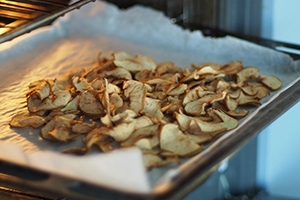
This might mean staying away from fruits. They can be very tricky to turn into powder.
Yes, they can be dehydrated, and be quite tasty and easier to store longer that way.
However, due to the higher sugar content than other foods, most fruits tend to get gummy in the process between dehydrating and pulsing in the blender.
Personally, I would just go with dehydration for fruits.
Related: How to Dry Plums for Long-Term Storage Just Like Grandma
Now, I will share information on turning a few of these into powder.
GREENS
They are not just a trend for the health conscious, but also a great addition to a daily diet for anyone, including preppers. Greens in their most natural state can add a lot of nutrients to salads, soups, or added to a sandwich…or any meal. But, they don’t always stay fresh for long.
However, dried greens can still be added to soups, sandwiches, and just about any meal with a great nutrient boost.
Here are a few greens to consider:
- Kale
- Spinach
- Collard Greens
- Beet Greens
- Broccoli leaves
- Cauliflower leaves
- Carrot tops
- Parsnip tops
- Celery leaves
- Mustard greens
- Turnip greens
- Swiss chard
- Lettuce
- Pumpkin leaves
- Radish greens
- Parsley
- Cilantro
- Basil
- Mint
- Rosemary
- Chives
- Oregano
- Sage
- Thyme
- Lemongrass
- Chervil
Related: 10 Spices That Make Your Food Last Longer
Even weeds! Basically, if it’s green…it can be done. And, here’s how…
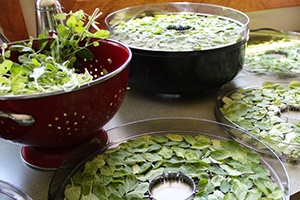 First step is to dehydrate the leaves. If you have a dehydrator, preheat it using the appropriate temperature setting based on your dehydrator’s recommendations.
First step is to dehydrate the leaves. If you have a dehydrator, preheat it using the appropriate temperature setting based on your dehydrator’s recommendations.
It will probably be about 95-115F. Set on the lower end for herbs, while greens can handle slightly higher temperatures.
While that is preheating, wash the leaves thoroughly by soaking them in a vegetable wash (2 parts water to 1 part vinegar and 2 tablespoons lemon juice). They don’t need to soak long, about 5-10 minutes is all they need.
Next, remove the stems and veins. This step will help in making the drying process more even and consistent. You can either compost the stems and veins or dehydrate them separately. But, no need to waste them.
Dry the leaves by hand as much as possible, by placing them between layers of paper towel and gently pressing to soak up as much moisture as possible, without bruising the greens.
You could also let them set on the counter to air dry, or use a salad spinner if you have one on hand.
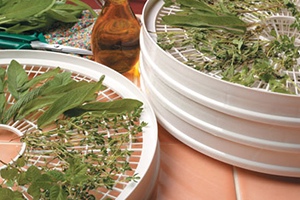 Place the leaves on the dehydrator trays. It doesn’t matter if they are touching, as long as they are not stacked on top of each other.
Place the leaves on the dehydrator trays. It doesn’t matter if they are touching, as long as they are not stacked on top of each other.
The leaves will start to shrink (up to ½ of their original size) so there will be plenty of room during the dehydrating process. The drying process can take 4-8 hours.
Once they crumble when crushing them between your fingers, they are ready. Place them in a blender and pulse quickly until they become a powder. Do NOT over blend, otherwise they will go from powder to mush.
Using the Oven
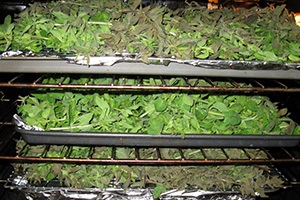
If you don’t have a dehydrator, you can use the oven.
Follow the other steps for preparation, while preheating the oven to the lowest possible temperature.
Place the leaves on cooling racks, then place in the oven. This might not sound right… but leave the oven door open during this process.
It will help keep the temperature low, as well as help to circulate the air to release excess moisture.
Check the leaves often, but they should be done in about 2-3 hours.
VEGETABLES
The process for vegetables can vary. However, they will all require a dehydrator or oven to help turn them into a powder. Here I will provide the process for the following:
- Onions
- Garlic
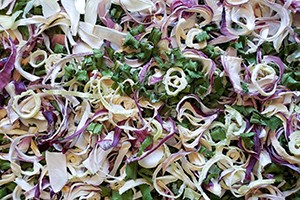 Onions and garlic should be sliced and put onto a dehydrator tray or cooling rack, just as in the process of the greens above.
Onions and garlic should be sliced and put onto a dehydrator tray or cooling rack, just as in the process of the greens above.
Now, slices of garlic and onion will fall through a cooling rack.
So, you might need to lay down some tin foil first.
Other vegetables should be blanched first, then sliced and follow the same process of dehydration as the greens. These vegetables include:
- Carrots
- Asparagus
- Beans
- Tomatoes
- Zucchini
This is just a short list. Basically, if it’s a vegetable, it can be turned into a powder.
Powdered vegetables can be used to enhance the flavors of soups, smoothies, or any meal. It can also help to add additional nutrients to your daily diet.
MEAT AND POULTRY
For meat and poultry, I am going to focus on using the oven, rather than a dehydrator. You can use both. However, I have actually used the oven before for meat powder.
When meat and poultry is turned into a powder, it can be used as a protein addition to any meal such as soups, stews, or casseroles, or just to enhance flavor. This includes:
- Beef
- Pork
- Chicken
Related: How To Make Bacon Powder
Preheat the oven to 200F.
Place the meat or poultry into a food processor and process it until it’s finely minced. It will resemble ground beef or poultry.
Heat some oil in a skillet, and put the minced meat in to cook for about 20-25 minutes, or until there’s no moisture anymore.
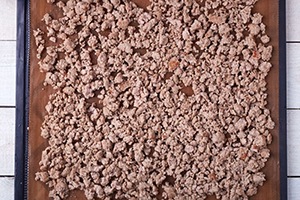
Spread the minced mixture onto a baking sheet that has been lined with parchment paper. Bake this for about 2-6 hours (stirring about every 30 minutes), or until it has completely dried.
Keep an eye on it, because the time could be widely different, depending on the ingredients used, and your oven.
Once the minced mix is completely dried and cooled, place the mix into a blender and use quick pulsing steps until it’s a fine powder.
If using a dehydrator, cook the meat first, then slice it very thin. Place the slices in the dehydrator trays, then follow the time chart of your particular dehydrator. Once you dehydrate them, pulse the slices quickly in a blender until it becomes a powder.
MUSHROOMS
It’s been said that mushrooms help reduce inflammation, lower cholesterol, boosts the immune system, and more. But, even if you don’t worry about any particular health concern, they also taste good.
If you are not familiar with the various types of mushrooms, you should do some research before venturing out to start collecting them. While the majority are healthy, some can be very harmful.
Related: Edible and Non-edible Mushrooms you Find in Forests
Anyway, after you find some healthy mushrooms, you can turn them into powder, by following these steps
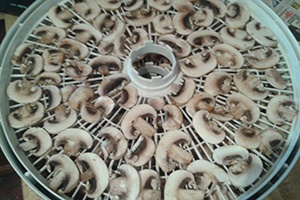 Wash the mushrooms thoroughly with water and a scrub brush or sponge.
Wash the mushrooms thoroughly with water and a scrub brush or sponge.- Slice each mushroom into thin slices, no thicker than ¼”.
- Place the slices in the dehydrator trays. Set the timer for the mushrooms, according to your dehydrator’s time chart.
Once the slices are dehydrated and cooled, place them in a blender and hit pulse a few times until they are in powder form. But again, make sure to not over pulse.
Storing Powdered Foods
Place your newly powdered food into an airtight container, and keep in a dry, cool, and dark area…such as a pantry or cupboard. Here is a breakdown of how long they should last, if stored properly.
- Greens – After about 6-9 months, you will notice the color fading. That is the point when you are losing nutrients. They won’t go bad, but the flavor and nutrition is diminishing as the color fades.
- Meats and Poultry – can be stored in an airtight container in a cool, dry, and dark place for up to 5 years if the seal has not been broken.
- Vegetables – if stored properly, can last up to a year for optimum freshness and maintain nutrients.
- Mushrooms – place in an airtight container, or seal with a food saver in individual packs. Powdered mushrooms should last in a cool and dry area for up to a year.
The more you open an airtight container, the more you allow air in, which will shorten the time it will keep fresh. If you break the product down into smaller batches for storage, the longer your product will last on the shelf.
Hopefully, this will give you a good idea on what you can do to turn some foods into powder, how to store it, as well as put it to good use.
You may also like:
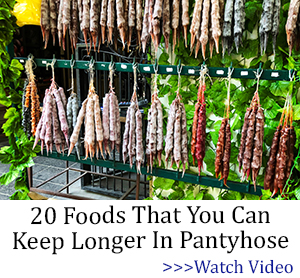 Best Canned Foods For Emergencies On The Market Today
Best Canned Foods For Emergencies On The Market Today
Why You Should Put Garlic In You Ear Before Sleeping (Video)
15 Simple Solutions to Help You Get Rid of Ants

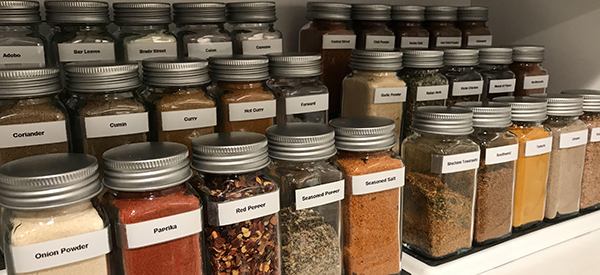













I don’t think this would work for other leafy items like lettuce , to thick and moist .
I put my mint leaves or shepherds purse in a brown paper bag and leave it in a dry dark place for a good week . Dump it out crush it to put in empty spice containers .
This is a great article. I never thought about turning these items into powder before.
Good article. Now maybe you can do an article on recipes to use powdered food.
Very good helpful information. I’m sure Raven will find a few things to criticize and nitpick.
How long would the veggies last if freeze dried and then turned into power and vacuum packed?
Hi, can you tell me how to freeze dry things at home please? I tried some freeze dried pineapple the other week and it was just lovely! I’d love to know how to do it.
You will have to purchase a freeze dryer. They aren’t cheap costing around $3000. Here is the web site for a medium sized freeze dryer:
Home Freeze DryerMy wife and I have one for about a year and love it.
Yum, crickets.
My wife ate crickets during WWII in Japan. Deep fry them after pulling off the legs. The legs are scratchy and don’t contain much in the way of food value. Now they are a chi-chi snack to be consumed with beer in the summer time. During WWII, it was to avoid protein deficiency that crickets were consumed. Crickets and grass hoppers both.
do not eat rhubarb leaves. not ALL greens can be eaten. i have dehydrated rutabega leaves, carrot tops, and beet greens, and ground elder and amaranth (weeds!). gonna try dandelion next, maybe tomato leaves, which are edible. have eaten raw, but not dried, green bean leaves. pumpkin leaves? hmm. i also grow grapes. i would take the seeds from tomatoes (at least) before dying as they would make a bitter powder.
can add these powders to homemade bread/biscuits/crackers, or mix into the butter to spread on them. just remember to be judicious–the flavor is intensified and a little will go a long way.
Very good info. Thanks KJ Barber, we need more of this. Medicinal powders. Would be nice. Even the hard ones to find.
Im Trying to increase my powder products. I like to keep my products in a chunky form so I can grind or crush as needed.
Need ways to keep them. Not to store but to uses, ok and to store also. Lol. Long term.
Have spices in half pint jars, I keep In my kitchen draw.
Need spice rack for my RV. Also They don’t taste as good when they all mix together.
Any ideas.
Thanks…
This one does and it’s easy to make too. I like to keep it in a shaker on the kitchen shelf. Equal parts black pepper, turmeric powder and garlic salt. A simple sprinkle does wonders on top eggs, potatoes and corn dishes.
Crab apples powdered for their pectin ?
Might be worth the experiment.
I would suggest that after pulverizing, one might want to return the pulverized product to the dehydrator/oven to remove remaining moisture.
I pulverize sweet potatoes and find them to be really handy. Can make up as many or as few mashed as I please. With my last batch, I was short on time and did NOT put them back on the dehydrator. I also did not wait until they were cooled completely before storing. Almost cooked completely, but not quite.
Went to use some, and I could smell the musty mold smell as soon as I opened the jar. The snell remained after I tried reconstituting them, and yes, I took a small taste. Yuck.
Lesson learned.
To give an idea of volume, I fit all but a couple tablespoons of dried product in a quart mason jar. I started with 17 sweet potatoes.
I live in a humid place, so it’s always a bit if a dance to allow the product to cool completely before storing AND not having humidity creep back in.
What I typically do when using these sweet potatoes is to keep some of the dried product in a smaller jar, which is my “working” jar, and the rest in the larger jar, minimizing the number of times I need to open it.
To reconstitute, I start with one part product to three parts water.
How much dry product do you use for a average serving per adult?
For the sweet potatoes I use about 1/4 cup dry and 3/4 cup water. That makes a nice sized serving at our house.
Good article? How about buy these already in powder form.
Stu, I respectfully disagree with you. This is a decent article. While I agree I would currently buy food products already powdered to save myself time, it’s best to learn how to do it anyways. If major SHTF happens and I run out of powdered food goods or if my food somehow gets destroyed, I can’t just run down to the store to buy more. Chances are there probably isn’t going to be a store.
You are right , it’s good to learn these things but if the means to make these things don’t exist then we won’t be making these things. For example, dehydrator and oven. Both run on electricity and if the grid is down then say goodbye to making powder formed goods. That is my point. Then good old hunting and trapping come into play and you eat what is caught in the God made solid form. These things are good to know but knowledge won’t feed you of means are non existence. Food for thought. Stock up on these things now and let the chips lie where they fall
sun oven and sun dehydrator both will work with the sun and propane can run an oven… just saying
you can still make powder products even in a SHTF scenario. always a way…
Meats and poultry? For extra flavoring? Last I checked they were called spices. Tell you what, instead of spending money on the meat then electricity and time to process your twelve dollar sirloin steak into powder, go to the store, spend twelve dollars on a bunch of ramen noodle packs(various flavors) put the noodles in a container to cook later and save the flavor packs to season your soups and whatever else.
I’ve dried greens and onions, crushed or put through a blender to powder them them for storage for years. I simply put powdered greens in a bowel and add boiling water then salt and olive oil to taste. They make descent greens in winter. Powdered onions, garlic, tomatoes and more are great as seasonings or soup base. Not hard to make, and tasty additions for winter or travel. Good additions to smoothies. I dry on screens in the sun or I had a solar dehydrator. Now I dry things in winter on screens hung over the heat collector of my pellet stove.
Glad to see this article. Its great advise. Broth or fruit dried till brittle may not easily powder but is useable if steamed or boiled.
The idea of using from a smaller container to not open the larger container so often is a good idea.
Much of this my parents were doing before me. My mother was a whizz at coming up with great ideas for preparing or storing food items. Dad was a registered dietitian with double BAs and double Masters degrees. Extra majors and minors from university in Botany, Chemistry, English, et. No books but many articles published. Mom was a gourmet cook but loved the simple rural life she and Dad grew up with. Both were adults during the Great Depression. I think that was a big part of why they embraced ideas for long term food storage.
The excess powdered herbs and vegetables left after filling jars was always mixed with powdered celery leaves and stirred into homemade yogurt or buttermilk. It made a descent dip or salad dressing years before it became a popular salad dressing.
Any extra vegetable leftovers were often dried and powdered or stored as whole vegetables to add to winter soups. Cooked, dried corn, powdered, adds a sweetness to surprising dishes. Powdered green peas are good stirred into guacamole. Powdered tomatoes or tomato skins are great with soups, beans, or chili dishes.
Experiment and have fun with it.
When drying things like parsIey or cilantro, dry the stems separately but powder them together with the leaves or powder just the stems.
Powdered eggs with called for water and a can of luncheon loaf or other spam blended in a blender and blended with some onion or onion powder then baked till set is pretty good.
Powdered eggs, called for water and an onion blended is then scrambled, used to make a quiche or omelets. Use powdered egg, water and onion stirred into potato flakes makes great potato panties fried to accompany a meal. Powdered egg, onion, water, a can of tuna or makeral and a bit of mayonnaise makes a good fish pattie with enough bread or cracker crumbs stirred in to hold it together then fry till golden. Some celery powder added to fish patties is good too.
I put some powdered greens in bowel. Stir in boiling water and stir into a paste. Then add salt and a little olive oil to taste. Eat as a serving of greens.
Make herb blends. Ie: taco mix, chili blend, BBQ seasoning et.
When my children were small (late 70’s/early 80’s), I would dehydrate as many vegetables as possible from our garden then make vegetable powders. A 1/4 cup of powder plus a couple of tablespoons of warm water made a puree to feed the toddler. All of my children were eating from the garden as soon as solid foods were introduced and straight from the table by 8-10 months. I knew exactly what was in their (& our) food from garden to table. We still raise about 85-90% of our own food (meats, vegetables, herbs, fruits, grains, dairy, etc. My only hiccup was a severe soy allergy in the youngest son. He couldn’t (& at 38, still can’t) be around green garden peas, or soy in any form. My kids never ate processed foods. I made any sweets (cookies, etc) as well as peanut butter (from our peanuts & peanut oil), breads, crackers, candies, etc so that I could make sure that he didn’t get ANY soy.
Hi, we are a Tech Startup. Exclusively into processing perishable into a powder. We are pioneer in cold processing (room temperature) … retaining taste and nutrients.
I would like to learn from your experience with food powder market.